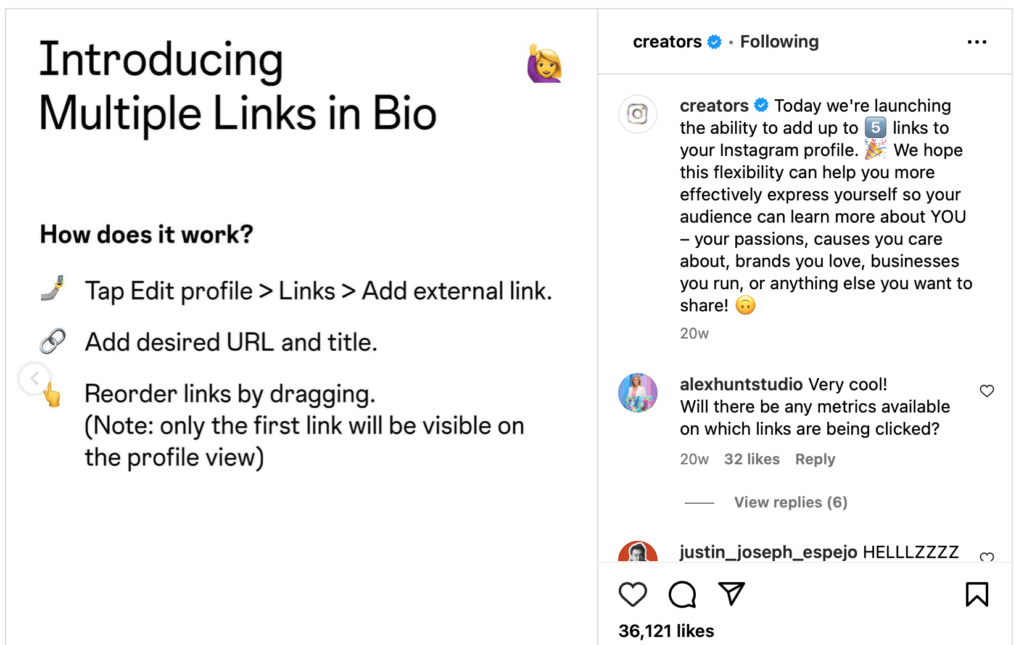
If there’s one central theme relating to social over the past decade-plus, it has been more is better. More frequent posts, more platforms, more followers, more images, video, technology. So the notion of restraint feels unusual, odd … even off-putting. But more is not always better. Read on about five Instagram myths.
Instagram myth #1: Load up on hashtags
From its early days, Instagram posts have loaded up on hashtags, often tipping the scale over post copy. Hashtags serve as search engines for posts on Instagram and other social platforms, guiding users to additional content on a topic. In reality, seeking to maximize hashtags can dilute a post’s effectiveness. Perhaps even more concerning, StatusBrew pointedly stated that going overboard with hashtags looks spammy and can make your brand appear less trustworthy.
How many hashtags are too many on Instagram?
An algorithm update in August 2023 specifically states that 3 to 5 hashtags is the sweet spot. Users accustomed to maximizing hashtags may be slow to adapt to this change, but their post visibility will be negatively impacted.
“Only use three hashtags per post. In one of the biggest updates to Instagram in 2023, the platform no longer wants users to use 8-15 hashtags and instead favors posts with 3-5.”
senditrising.com
Say it all in the post copy: #2 of Instagram myths
Unlike many other social platforms, Instagram does not support the use of links within posts. Accounts seeking to direct viewers to a call to action link circumvent this challenge by including the phrase “link in bio” in the post.
While only the first link will be visible on the profile view, Instagram actually enables users to add up to five links in the bio. The process to do so is very straightforward … simply Edit profile > Links > add external link.
Pro tip: When seeking to drive visits to a particular link, an account holder can re-sequence the bio links to shift the desired one to the top position.

Longer reel = more time to engage: #3 of Instagram myths
Implying … thumbs-up for longer reels?
Nope again. On Instagram, make your mark, pronto. In fact, While in-app reels can be from 15 to 90 seconds long, multiple sources cite 7-15 seconds as the ideal reel length to maximize impressions and engagement.
Seems quick, but it’s partially about how the views are counted. Short reels will loop, counting as multiple views until a viewer clicks away.
Hootsuite says the short reels “leave your audience wanting more,” which may prompt them to “engage with your other reels, sending the algorithm positive signals about your content.”
Instagram myth #4: Live by the clock
The million dollar social media question: When is the best time to post on social?
Over the past few years, social scheduling tools have included optimal times to post for maximizing views and engagement. Is it bunk? Has the landscape changed? Or does it depend on who’s answering the question?
We dug around for some highly credible sources. SocialPilot’s blog article states that Instagram users engage more on weekdays, with Wednesday and Thursday showing the most engagement.
In contrast, a post in SEM Rush includes a chart of average social engagement by time of day, noting that weekend engagement is highest on Twitter and Instagram, and Facebook engagement is highest on Mondays.
Confounding, right? But there’s a bigger picture. Semrush followed with this key finding:
“Content type had a larger impact on engagement than posting date or time … When viewed together, posting day and time did not have a significant impact on engagement”
So, the bottom line: What you say and how you express it matters more than when you share it.
Reels are the holy grail: #5 of Instagram myths
Let’s back up and read that last sentence again. What you say and how you express it matters more than when you share it. While it’s generally accepted that reels on Instagram generate the highest engagement, is there more to it?
For a cosmetic or fashion brand, perhaps reels are the holy grail. But for your industry or line of business? Semrush did a deep dive study of tech brands, analyzing a years’ worth of social content specifically focused on post timing and content type. The study noted a disconnect between the content types that generated the highest engagement and the content types most frequently utilized by the tech companies.
One surprise finding of the study was that while the most frequently posted content type was reels, the highest engagement was generated from carousel albums.
“Despite their high performance, carousels were the least popular type of post, comprising only 21.1% of content. Videos were the most frequent with 41.7%.”


